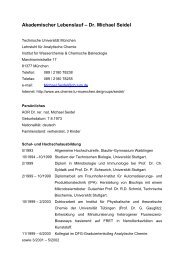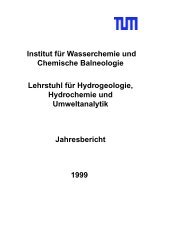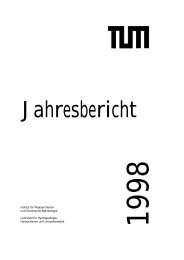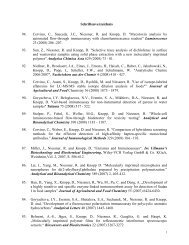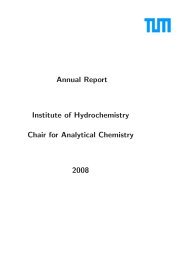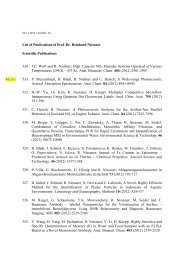IWC Annual Report 2003 - Institut für Wasserchemie und chemische ...
IWC Annual Report 2003 - Institut für Wasserchemie und chemische ...
IWC Annual Report 2003 - Institut für Wasserchemie und chemische ...
Create successful ePaper yourself
Turn your PDF publications into a flip-book with our unique Google optimized e-Paper software.
1.3.2 Development of Immunochemical Methods for the Detection of Food<br />
Allergen Traces<br />
F<strong>und</strong>ing: EU QLRT-2000-01151 Cooperation: IFA Tulln, Austria (Prof. Krska);<br />
RIKILT, The Netherlands (Dr. Haasnoot); CSL, UK (Dr. Banks); r-Biopharm, Germany<br />
(Dr. Schmitt); UNIMI, Italy (Prof. Restani); VU, Belgium; CMHT, UK (Dr.<br />
Wilson)<br />
Lack of complete knowledge about the food composition may be hazardous for allergic<br />
patients. Even traces of certain proteins can result in fatal reactions so the only<br />
effective measure for these individuals is an avoidance diet. This, however, could be<br />
<strong>und</strong>ermined by “hidden allergens” which may be caused by cross contaminations, for<br />
example in chocolate, cookies and ice cream or in food prepared in restaurants.<br />
Allergies to peanut and hazelnut proteins are particularly<br />
prevalent and severe. Hence, our project is focused<br />
on the development of detection systems for these allergens.<br />
There is a need for sensitive lab-based immunoassays<br />
(ELISA) for routine analysis and rapid easy-to-use<br />
test strips, which might be even used by the consumer.<br />
1.0<br />
Up to now we received about 100 different antibodies from<br />
0.8<br />
our partners, monoclonal as well as polyclonal ones from<br />
several species. We characterized all the antibodies apply-<br />
0.6<br />
ing various test formats to get information about affinities<br />
and application conditions such as dilution factors or in-<br />
0.4<br />
cubation times. Furthermore, we had to identify matching<br />
pairs; antibody combinations which are suitable for sand-<br />
0.2<br />
wich immunoassays. Homologous as well as heterologous<br />
pairs were screened, especially combinations consisting of<br />
two monoclonal mouse antibodies. For both peanut and<br />
hazelnut detection we fo<strong>und</strong> various matching pairs which<br />
showed excellent sensitivities.<br />
(M. Kiening)<br />
0.0<br />
1.3.3 Development of a Method for Effect Related Analysis of Toxins<br />
F<strong>und</strong>ing: BMBF 02WU0331<br />
Cooperation: <strong>Institut</strong>e of Technical Biochemistry (Stuttgart), German Research Centre<br />
for Biotechnology (Braunschweig)<br />
Gro<strong>und</strong>water and surface water are often contaminated by a complex mixture of<br />
chemicals, which could be of anthropogenic or environmental origin. The enormous<br />
variety of the compo<strong>und</strong>s prevents a complete chemical analysis. The relevance of the<br />
substances for the ecosystem and human health is usually assessed by using biotests.<br />
Test organisms are mussels, algae, fishes as well as microorganisms such as luminescent<br />
bacteria. However, with these tests only the acute toxicity to the specific organisms<br />
can be assessed and no information on the compo<strong>und</strong>s causing the effects is provided.<br />
Furthermore, besides toxic substances, the mixture could contain substances like pharmaceuticals,<br />
which may show unwanted effects to the ecosystem. The effect-related<br />
analysis combines chemical analysis and toxicity tests. After a physicochemical separation<br />
the substances pass a biochemical detector. In this detection unit biomolecular<br />
recognition elements are embedded, which detect a potentially toxic effect of the analyte.<br />
Relative Absorbance (450 nm)<br />
0 0.1 1 10 100 1000<br />
Concentration Peanut [µg/L]<br />
15



